Sun-dried herbs create the perfect foundation for rich, flavorful stews. You'll want to harvest herbs at peak freshness, bundle them with twine, and hang them upside down in a ventilated area for 3-4 days. For classic French-style stews, try combining dried thyme, rosemary, and savory (known as Herbes de Provence) or create your own blend by mixing dried herbs with spices like paprika and cayenne. Store your dried herbs in airtight glass containers away from sunlight, and add them early in the cooking process to release maximum flavor. Exploring traditional herb combinations will transform your stews into memorable meals.
Understanding Sun-Dried Herb Preservation
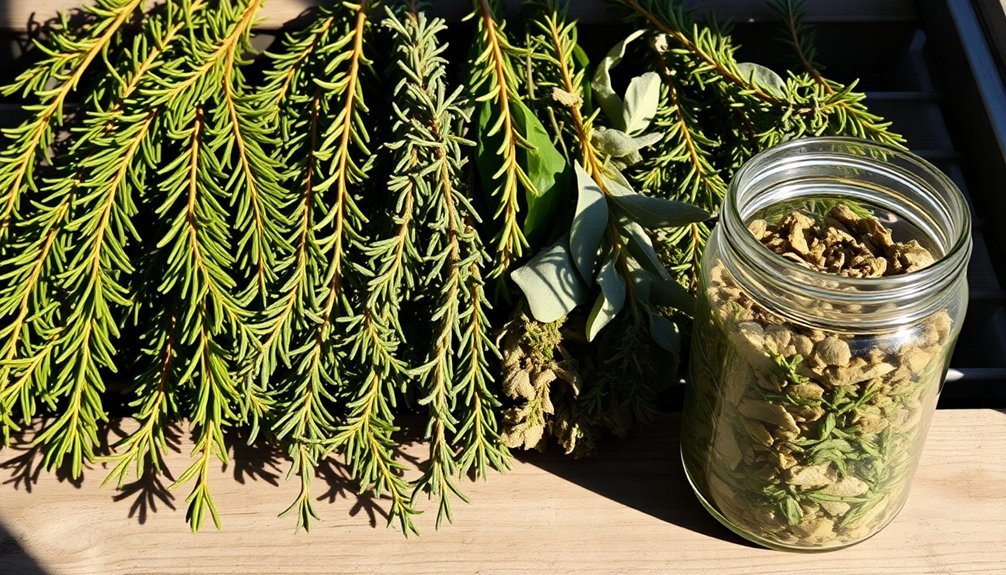
When you're preserving herbs through sun-drying, proper preparation and technique are essential for maintaining their flavor, aroma, and shelf life.
Start by selecting herbs at their peak, removing any damaged leaves, and bundling them with twine. Hang these bundles upside down in a well-ventilated area, protected from direct sunlight.
You'll want to wrap the bundles in brown paper bags with ventilation holes to keep dust away while allowing air circulation. The process typically takes 3-4 days, but if herbs aren't completely dry within two weeks, finish them in a 100-degree F oven. Using dried herbs in cooking requires remembering they are more potent than fresh.
Once dry, pasteurize them at 160 degrees F for 10 minutes to eliminate any insects or eggs. Store your dried herbs whole in airtight containers, and only crush them just before use to preserve their oils and flavors.
Traditional French Herb Mixtures
You'll find three essential French herb combinations that can transform your stews:
Herbes de Provence, a sun-dried blend featuring thyme and rosemary;
Bouquet Garni, a tied bundle of thyme, bay leaf, and parsley;
and Fines Herbes, a fresh mixture of parsley, chives, chervil, and tarragon.
Each mixture serves a distinct purpose, with Herbes de Provence ideal for robust flavoring, Bouquet Garni perfect for simmering and removal, and Fines Herbes best for delicate finishing touches.
Originally used in French country cooking, Herbes de Provence has evolved into a versatile blend that enhances both traditional and modern stews.
These classic French combinations showcase centuries of culinary wisdom, helping you achieve authentic flavors in your stews and other dishes.
Classic Herbes De Provence
The classic Herbes de Provence blend represents a cornerstone of French culinary tradition, featuring precise proportions of dried herbs according to Label Rouge specifications.
You'll find a carefully balanced mixture of 27% each of savory, rosemary, and oregano, complemented by 19% thyme.
While North American versions often include lavender, traditional French blends stick to these four essential herbs. Creating your own blend at home ensures superior freshness compared to store-bought versions.
You can use this versatile mixture to enhance your marinades, stews, and roasted dishes. It's particularly effective in classic Provençal recipes like ratatouille and tapenade.
When preparing your blend, you'll want to grind rosemary slightly finer for better integration.
Store your mixture in an airtight container in a cool, dry place, and you'll enjoy its robust flavors for several months.
Bouquet Garni Essentials
Moving from regional herb blends to time-honored French cooking methods, a classic bouquet garni stands as another pillar of French culinary tradition.
You'll need three essential herbs to create this versatile bundle: thyme, parsley, and bay leaf. While these form the foundation, you can enhance your bouquet garni by adding sage, rosemary, savory, fennel, celery, or tarragon.
You've got several ways to prepare this herb bundle. Tie fresh herbs with kitchen twine, wrap dried ones in cheesecloth, or create a leek envelope to hold everything together.
The method you choose depends on whether you're using fresh or dried herbs. When you're making stews, soups, or classic dishes like Coq au Vin, simply drop in your bouquet garni and remove it before serving. The long cooking time allows these aromatic herbs to fully infuse your dishes with rich, complex flavors.
Fines Herbes Composition
French cuisine's delicate fines herbes blend consists of four essential soft-leaved herbs: parsley, chives, chervil, and tarragon.
You'll find these herbs working together to create subtle, sophisticated flavors that won't overpower your dishes. While you can use either fresh or dried herbs, fresh varieties offer the most vibrant taste when added near the end of cooking.
For an enhanced flavor profile, you can incorporate these optional herbs:
- Marjoram or sweet cicely for a gentle, sweet note
- Fresh dill or basil for bright, aromatic qualities
- Lemon balm to add citrus undertones
- Thyme for earthy depth
Store your fresh blend in an airtight container for up to two weeks, or keep dried mixtures for four months in a cool, dark place.
Mediterranean Dried Herb Combinations
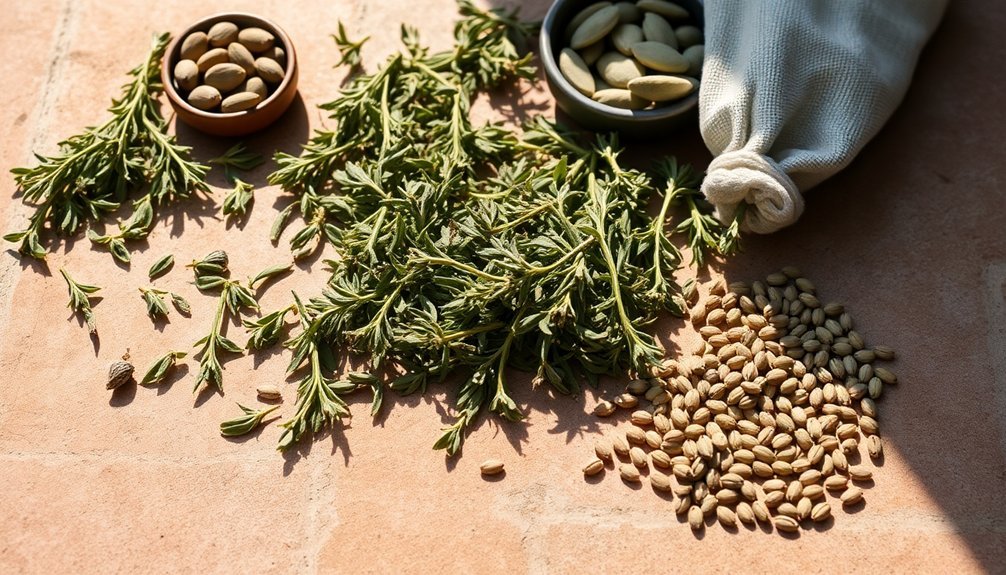
Mediterranean dried herb combinations bring robust flavors and centuries-old traditions to your stews and soups. You'll find that classic blends like herbes de Provence combine thyme, basil, marjoram, and oregano to create complex flavor profiles. For the best results, you can customize these combinations based on your preferences.
| Herb/Spice | Best Used In |
|---|---|
| Oregano & Thyme | Meat-based stews |
| Basil & Parsley | Light vegetable soups |
| Coriander & Cumin | Hearty legume stews |
| Rosemary & Garlic | Root vegetable dishes |
| Paprika & Pepper | Seafood broths |
When blending these herbs, you'll want to grind them fresh for maximum flavor. Start with small batches and adjust the proportions to suit your taste. Remember that Mediterranean herbs don't just add flavor—they're packed with anti-inflammatory and cardioprotective properties that enhance your dishes' nutritional value.
Proper Storage Methods
After mastering your Mediterranean herb combinations, you'll need to store them properly to maintain their potent flavors. Your carefully dried herbs deserve proper storage to preserve their aromatic qualities and extend their shelf life.
- Confirm your herbs are completely dry before storing them – they should crumble easily when rubbed between your fingers.
- Choose glass jars or metal tins with tight-fitting lids, avoiding plastic containers that might affect the herbs' flavor.
- Keep your stored herbs away from direct sunlight by using dark-colored containers or storing them in closed cabinets.
- Select a cool, dry location away from heat sources like stoves and ovens.
Remember to label each container with the herb's name and date. With proper storage, you'll have flavorful herbs ready for your stews throughout the year.
Drying Herbs Under Natural Sunlight
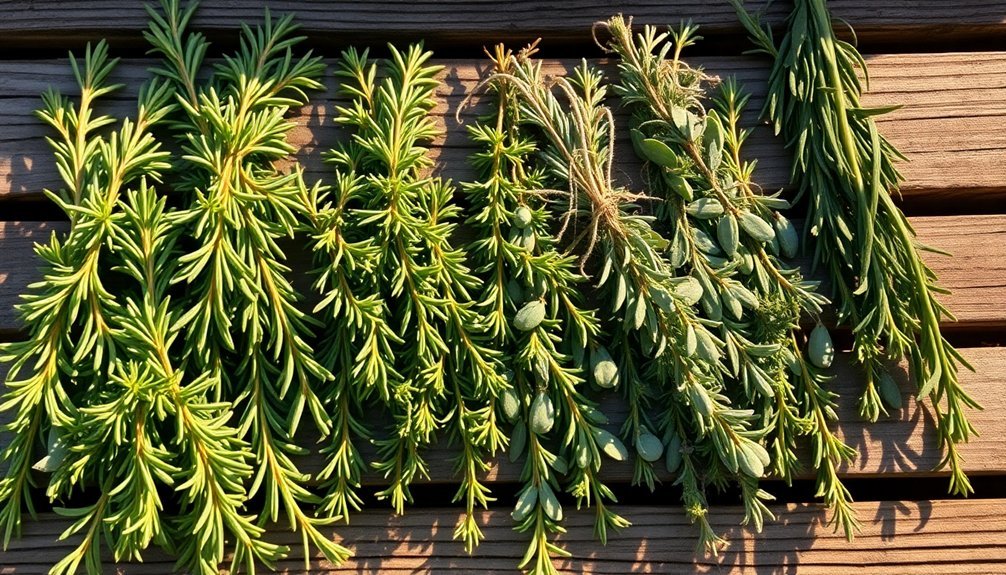
Despite its traditional appeal, drying herbs under direct sunlight isn't always the best approach for preserving their flavors and aromas. Instead, you'll get better results by hanging your herbs in a cool, dry place away from direct sun exposure.
To properly dry your herbs, start by washing and thoroughly drying them with a salad spinner or towel. Then, tie them into small bundles using string, leaving about an inch and a half of bare stem.
Hang these bundles upside down in a well-ventilated area. The process typically takes two weeks.
If you're dealing with tender-leafed herbs like mint or basil, consider using alternative methods such as an oven or dehydrator. These options provide better control over temperature and humidity, reducing the risk of mold while preserving the herbs' essential qualities.
Herb-to-Vegetable Pairing Guide
You'll find that basil, chives, and parsley create perfect matches with leafy greens like spinach, cabbage, and Brussels sprouts.
For your root vegetables, consider how chives can brighten carrots and potatoes, while rosemary and thyme excel with roasted root vegetables.
These herb pairings not only enhance the natural flavors of your vegetables but also add depth to your stews and other cooked dishes.
Leafy Greens Herb Matches
Pairing the right herbs with leafy greens can transform ordinary vegetables into extraordinary dishes.
You'll find that basil and parsley offer versatile flavors that complement everything from spinach to kale, while mint adds an invigorating twist to arugula and mixed greens. Chives provide a subtle onion note that enhances most leafy vegetables without overpowering them.
- Combine basil, lemon, and garlic with sautéed greens for a Mediterranean-inspired dish.
- Mix parsley into tabbouleh with fresh greens for a Middle Eastern flair.
- Add mint to yogurt-based dressings for a cooling effect on spicy greens.
- Blend chives with butter to create a flavorful finish for steamed vegetables.
These combinations work particularly well in stews, where herbs can infuse their flavors deeply into the greens during slow cooking.
Root Vegetable Flavor Enhancers
While root vegetables shine on their own, the right herbs can elevate their earthy flavors to new heights.
You'll find that rosemary and thyme form a classic pairing with beets, carrots, and parsnips, while sage works wonders with sweet potatoes. When you're experimenting with herbs, start with small amounts and build up to your desired taste.
You can't go wrong with tried-and-tested combinations like balsamic vinegar with rosemary and thyme, or the robust blend of Herbs de Provence.
For specific vegetables, try pairing beets with rosemary and thyme, carrots with oregano and sage, or sweet potatoes with basil.
Whether you're using fresh or dried herbs, you'll discover that these aromatic additions transform simple root vegetables into memorable dishes.
Creating Custom Dried Blends

Creating custom dried herb blends offers endless possibilities for enhancing your stews and other dishes. You'll want to start with thoroughly dried herbs, mixing classic options like rosemary, thyme, and oregano with complementary spices and seasonings.
For the best results, gather your herbs in the early morning after the dew has evaporated, then wash and dry them completely before processing.
- Combine dried herbs with spices like paprika, cayenne, or celery seed for depth
- Add texture with sesame, poppy, or chili seeds
- Incorporate dried aromatics like onion powder, garlic, or ginger
- Mix in dried citrus zest for brightness
Store your finished blends in airtight containers in a cool, dark place, and remember to label and date them.
When using these concentrated blends, start with 2-3 tablespoons per pound of meat in your stews.
Timing Your Herb Additions
Once you've crafted your perfect dried herb blend, mastering the timing of herb additions will maximize their impact in your stews.
Add your dried herbs at the start of cooking, as they need time to fully release their concentrated flavors into the dish. Remember, dried herbs are three to four times stronger than fresh ones, so use just one teaspoon for every tablespoon of fresh herbs called for in your recipe.
For layered flavor, consider a two-step approach: Add woody herbs like rosemary and thyme early in the cooking process, then brighten your stew with delicate herbs in the final minutes.
You'll want to bruise fresh herbs before adding them to release their essential oils. For an extra burst of flavor, top your finished stew with a fresh herb garnish or gremolata.
Essential Base Herbs
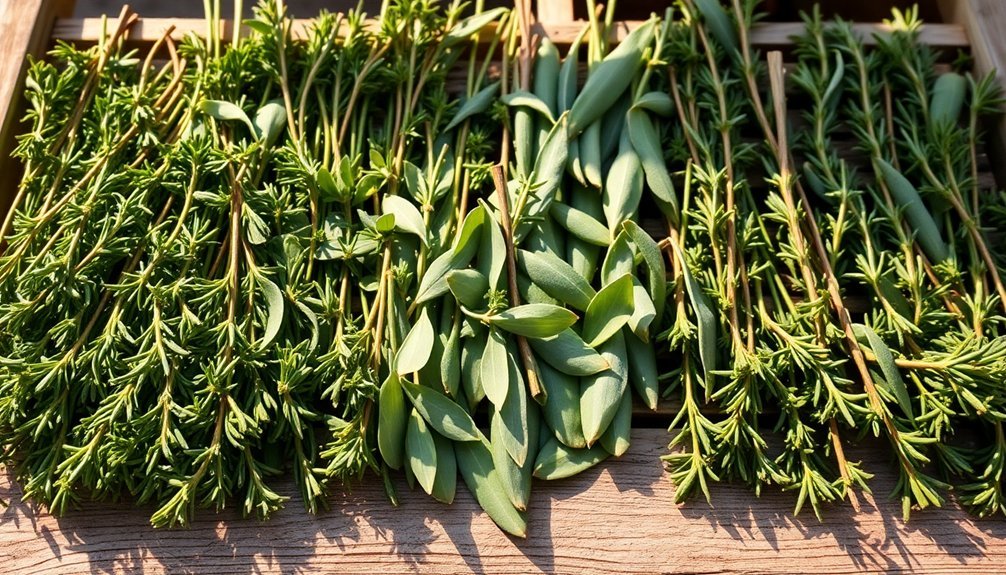
To build a flavorful stew, you'll need a reliable foundation of essential base herbs that work together harmoniously. Start with classic combinations like basil and oregano for tomato-based stews, or thyme and marjoram for hearty beef variations.
You'll find these versatile herbs create depth while complementing rather than overwhelming your main ingredients.
- Combine dried rosemary and bay leaves for rich beef stews
- Mix oregano and thyme for Mediterranean-inspired vegetable stews
- Blend basil and marjoram for a sweet, aromatic foundation
- Partner sage with thyme for earthier flavor profiles
Don't forget to include complementary herbs like garlic and black pepper to enhance your base flavors.
For vegan stews, you'll get excellent results with Italian herb blends, while warm spices like cumin and paprika can add extra dimension to any variation.
Seasonal Drying Calendar
You'll want to dry your cool-season herbs like parsley and cilantro in early spring before they bolt, while warm-season herbs can be dried throughout summer and early fall.
By planning your drying calendar around peak harvest times, you're able to preserve the best flavors for your stews year-round.
Keep your dried herbs in sealed glass jars away from heat sources, and you can maintain their robust flavors for up to six months.
Peak Harvest Drying Times
Understanding your herb's peak harvest times guarantees the most flavorful and potent results for sun-drying.
You'll want to harvest most leafy herbs before they flower, while seed-producing varieties need time to mature and darken. For perennial herbs, stop harvesting by late August to help them store energy for winter survival.
- If you're collecting annual herbs like basil or cilantro, continue harvesting until the first frost hits.
- For flowering herbs such as lavender, pick them when buds appear but haven't fully opened.
- When harvesting woody herbs like rosemary or oregano, you can gather them throughout the growing season.
- Choose early morning hours after the dew dries but before intense sunlight hits the plants.
Multi-Season Herb Storage
Planning your herb drying calendar across multiple seasons guarantees you'll have a steady supply of dried herbs throughout the year.
You'll want to store tender herbs like basil and mint at room temperature in a light area, while hardier herbs can go in the refrigerator in Mason jars with water and a plastic bag cover.
For long-term storage, you've got several drying options. Set your dehydrator between 95°F and 115°F, or bundle sturdy herbs like rosemary and thyme for air drying.
If you're working with tender-leaf varieties, use perforated paper bags to prevent mold. Once dried, store your herbs in airtight containers in a cool, dark place.
Remember to crumble leaves before storage if desired, and note that dried herbs are 3-4 times more potent than fresh ones.
Flavor Intensity Control
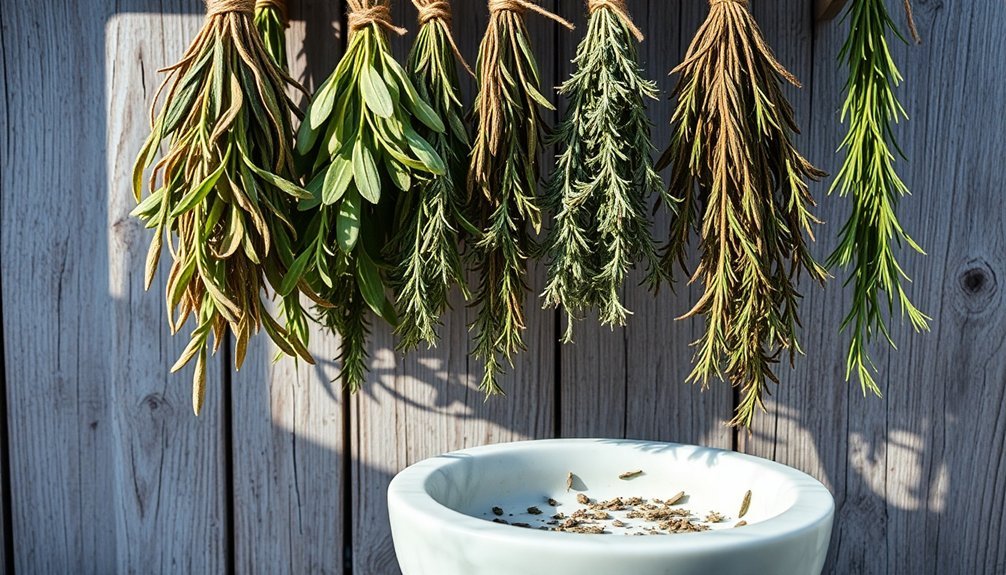
Managing the intensity of dried herbs in stews requires careful attention to their unique characteristics and potency levels. You'll find that robust herbs like rosemary and thyme need less quantity than delicate ones, as they retain their flavors better during the drying process.
To control flavor intensity effectively, add your dried herbs early in the cooking process, allowing at least 20 minutes for proper integration.
- Crush herbs gently between your fingers to release essential oils before adding them to your stew.
- Start with less than the standard 3:1 dried-to-fresh ratio when using woody herbs.
- Taste and adjust throughout cooking, as potency varies by brand and age.
- Monitor herbs' aromatic strength by smell before adding to prevent overwhelming the dish.
Remember to check your dried herbs' quality regularly, as their volatile oils degrade over time, affecting overall flavor intensity.
Regional Stew Herb Combinations
Traditional regional herb combinations offer distinct flavor profiles that define the character of stews across different cultures.
You'll find French stews enriched with either herbes de Provence or bouquet garni, featuring thyme, marjoram, and bay leaves as foundational elements.
Mediterranean stews lean heavily on the classic trio of basil, oregano, and garlic, often brightened with lemon and black pepper.
For Persian stews, you'll want to incorporate fresh parsley and mint, along with warming spices like turmeric. These combinations create the signature sour-savory profile that's characteristic of Persian cuisine.
Indian stews take on complex depths through garam masala and curry powder blends, where you'll combine earthy cumin and coriander with aromatic cardamom and fennel, plus fresh herbs like cilantro and mint.
Fresh-to-Dried Conversion Measurements
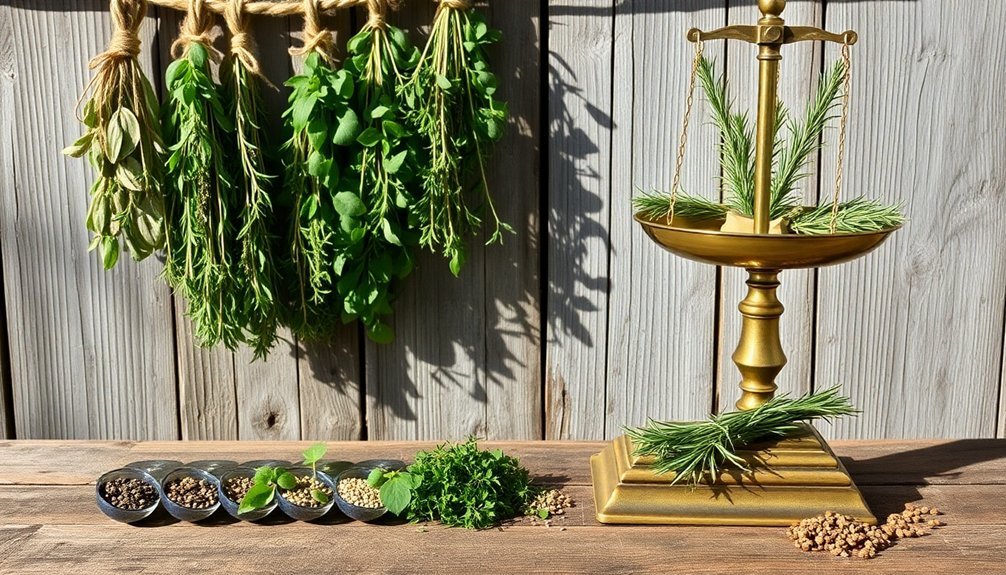
Once you've selected your preferred herb combinations, understanding the conversion between fresh and dried herbs becomes the next key step.
When adding herbs to your stew, you'll need to adjust quantities based on whether you're using fresh or dried varieties. The general rule is a 3:1 ratio of fresh to dried herbs, but some herbs require specific measurements.
- Start with 1 tablespoon of fresh herbs for every 1 teaspoon of dried herbs.
- For rosemary and cilantro, maintain the standard 3:1 ratio.
- With sage and basil, use a 2:1 ratio (2 teaspoons fresh = 1 teaspoon dried).
- For bay leaves, reverse the ratio – use 2 dried leaves for every 1 fresh leaf.
Remember to add dried herbs early in the cooking process, allowing their flavors to fully infuse into your stew.
Frequently Asked Questions
Can Sun-Dried Herbs Trigger Allergies Different From Fresh Herbs?
You won't notice much difference in allergic reactions between sun-dried and fresh herbs, as they contain the same allergenic proteins and compounds. The drying process might actually concentrate these allergens, increasing reaction potential.
Do Pesticide Residues Concentrate When Herbs Are Dried in Sunlight?
Yes, you'll find that sun-drying concentrates pesticide residues in herbs by 1.27-5.19 times their original levels. This happens because water evaporates during drying while pesticides remain and become more concentrated.
How Do Altitude and Humidity Affect the Potency of Sun-Dried Herbs?
You'll find that higher altitudes can boost your herbs' VOCs but reduce phenolic compounds. High humidity during drying will decrease potency, so you'll want dry conditions to preserve your herbs' beneficial compounds.
Which Herbs Should Never Be Dried Together Due to Flavor Contamination?
You shouldn't dry rosemary with basil or mint, as their flavors will clash. Also, avoid drying sage with rosemary, as they'll create bitter notes. Keep thyme and oregano separate from delicate herbs.
Can Moon-Dried Herbs Offer Different Properties Than Sun-Dried Herbs?
Yes, you'll find moon-dried herbs often retain more delicate essential oils and subtle compounds since they're not exposed to harsh sunlight. They're believed to preserve unique energetic properties aligned with lunar phases.
In Summary
Sun-dried herbs let you preserve summer's bounty while concentrating robust flavors for your hearty stews. You'll find that mastering proper drying techniques and storage methods guarantees your blends stay potent year-round. Whether you're creating a traditional French bouquet garni or Mediterranean mix, you've got endless possibilities to enhance your cooking. Start with small batches, experiment with combinations, and you'll soon develop signature blends that transform ordinary stews into extraordinary meals.

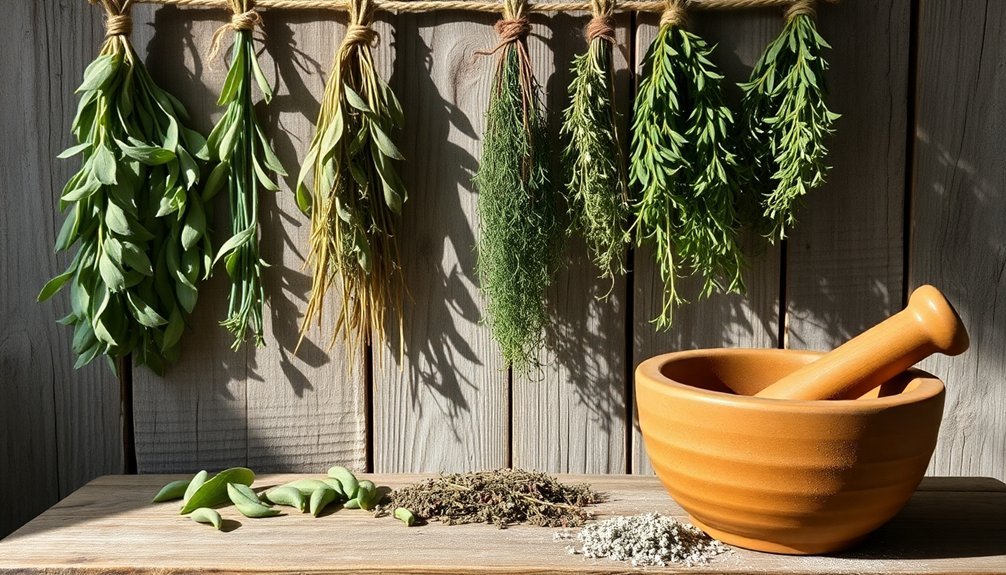



Leave a Reply